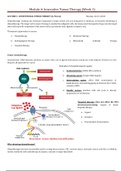Module 4: Innovative Tumor Therapy (Week 1)
LECTURE 1: CONVENTIONAL TUMOR THERAPY (G. Peters) Monday, 26/11/2018
Chemotherapy: utilizing any chemical compound to target certain cell; any drug given is chemical, so basically everything is
chemotherapy. The target cell in cancer therapy is mainly the malignant cells, but many novel therapeutic drugs can also target
other cells/specific component of the tumor cells (e.g. immune cells, ligands, receptors, etc)
Therapeutic approaches in cancer:
a. Chemotherapy d. Hormonal therapy
b. Antiangiogenic therapy e. Monoclonal antibody therapy
c. Targeted therapy
Tumor chemotherapy
Characteristic: DNA-directed, cytotoxic to tumor cells, use of agents that induce toxicity (to some degree) there’s no one-
drug-for-all approach for cancer
Examples of chemotherapeutic agents:
a. Antimetabolites: inhibit DNA synthesis
b. Alkylating agent: disrupt DNA integrity
c. Intercalating agent: affect DNA transcription &
duplication by intercalating/going in between the 2 helix
strands of DNA
d. Spindle poison: interfere with cell cycle to disrupt
progression of cell division
Targeted therapy: does not affect the DNA
structure/processing; targets of tumor
targeted therapy:
a. Ligand
b. Receptor
c. Final product/transcription
Why choosing chemotherapy?
Chemotherapy has been successfully used in curing breast cancer, CRC, cervical cancer, testicular cancer, and ALL in children;
mostly combined with radiotherapy & surgery, outcome is stage-dependent
, Module 4: Innovative Tumor Therapy (Week 1)
Targeted therapy has been successfully used in curing CML, GIST, and lung cancer (to little extent prognosis only improves
minimally, survival only increases for 1 year)
Development of chemotherapeutic agents:
a. Serendipitous = finding the substance by chance/initially wasn’t looked for (e.g. mustard gas as the basis of
alkylating agent development)
b. Rational design = folic acid as the basis of antifolate development (for ALL)
Classification of chemotherapeutic agents
Principles of chemotherapy
Kinetics of cancer therapy
Factors affecting drug activity:
a. Tumor mass (how big is it
when discovered? How late is it
when discovered?)
b. Tx administration (how early
is it treated?)
c. Cure capability of the drug
d. Immune mechanism (how
robust)
, Module 4: Innovative Tumor Therapy (Week 1)
ADME (administration, distribution, metabolism, excretion)
a. Administration route:
oral/intravenous
b. Distribution (through capillary):
influx & efflux of drug
c. Metabolism (liver):
elimination/activation of drug
d. Excretion
Influx-ed drug would undergo several
processes: sequestration, activation,
inactivation, distribution to target
Phase 1 metabolism vs. phase 2 metabolism
Phase 1:
Phase 2:
Mechanism of action
Important problems to remember when
adjusting/administering chemotherapy:
a. Dose intensity (BSA-based, fixed dose,
total dose given)
b. Route of administration
c. Schedule of therapy
(intermittent/continuous dose)
Role of chemotherapy in cancer: induce Tx for
advanced diseases, adjuvant to local methods of
Tx (breast cancer, CRC), primary Tx (leukemia),
direct installation into local sites/site directed
perfusion (to deep-seated organ, e.g. brain, liver,
bone)
When to administer chemotherapy?
a. Immediately before/after surgery eradicate micrometastases & may be concomitantly given with other Tx
b. Chemotherapeutic alone (e.g. for leukemia)
c. Combination with radiotherapy (e.g. for GBM, combine TMZ with radiation Tx)
d. Combination with immunotherapy (e.g. NSCLC)
, Module 4: Innovative Tumor Therapy (Week 1)
Side effects of chemotherapy Chemotherapy & targeted therapy both have
potential, dose-limiting side effects. Things to
consider when evaluating toxicity:
a. Time (acute/subacute/chronic,
delayed onset/early onset)
b. Reversibility
c. Organ specificity (gonad, neurons, etc)
d. Fatigue & malaise
e. Compromised health status (myelo-
/immunosuppression)
f. Local side effects (extravasation of
drug)
g. Possibility of developing 2nd
malignancy
Resistance can occur for any types of drug; In cases where certain compound is the only approved/available agent of certain
cancer, is it mandatory for clinicians to prevent SE before it occurs (whether it would/not occur doesn’t matter)?
Managing toxicity:
a. Dose reduction e. Hematopoietic growth factors
b. Scheduling (duration, delay, route of f. Adding chemoprotective agents (Mesna,
administration) Thiosulfate, Aminofostine)
c. Hyperhydration & transfusion g. Using analogs of compound
d. Antiemetics
Specific drugs for chemotherapy
To be discussed here:
a. Platinum-based drug
b. Microtubule-targeting agents
Most drugs are utilized as combination therapy
improve efficacy of drugs
Drugs have different mechanism of action,
different mechanism of resistance &
compatibility of drug side effects should be
taken into account





